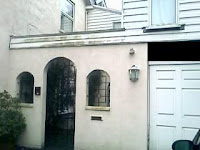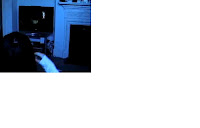1. in what ways does your media product use, develop or challenge forms and conventions of real media products
• The themes and issues used the film came from: a selection of thriller films in which people are stalked and followed into their own home films like the first scream movie has some aspects we have used to create the opening to our film deception.
• The antagonist idea of our film is not seen or heard which is until the end where you see the side of their head which is similar to the opening to scream. An antagonist is a person or group of people who oppose a main character or main characters.
.
low key lighting helps in which it helps the audience relate to the main character like she an iconic figure with the light on her face showing all of her facial expressions to what is going on within the film.

the way her style of clothing goes with the film is that shes just come home from a day out and really cant be bothered so as of this she wears lose easily fitting clothes.the style of her house is nice and big as its spacious house and big enough for other people to enter her house and creep up on her, also set in a nice location in which she lives in. (Setting/props/location) .
- the style of house that was used in the opening to scream was similar to the one we used as of its style as a big white house making it look peaceful and non treating environment until things start to happen
- facial expressions is shown to what is happening in the film is put across to the audience as a very shocked and confused person while all the tricky within her house is going on with the T.V and the phone ringing.
• Camera shots used in the film where a wide variation of shots with the main and biggest shot at the beginning of the film with a panning big long shot of the car pulling up into the drive. As well their was a wide selection of shots used in the film with another great shot of when the protagonist is walking through her gate and into her front door which is a panning long shot which I like as it’s a straight and very clear shot which out of the whole film I think that’s the best shot . In our production we where going to use a point of view shot of the killer/stalker but we didn't go through with it because it didn't really work well but used a shadow effect instead to create more suspense but the idea originally came from 28 day later in which there is a shot from the p.o.v shot of an infected individual.
• Protagonist idea from our film came across as a women coming back from shopping to an empty house the style she wares is a home relaxing outfit with the style of clothing that they where wearing this idea came from cloths warn in desperate housewives with the way that she walks to the style of her clothing.
• The music we have used changes when the feeling of the film changes like when the shadow appears the music changes to a more action thriller type which as the music changes the mood of the film changes with the audience.
• The sound effects used where mostly chosen on garage band but sounds like the cars clicking, breathing of the antagonist where recorded using a recording device which helps the film creates suspense in a way that suites our film much better with a variety of garageband used and our own recorded creations .
An example of Non-diegetic sound
http://www.youtube.com/watch?v=8VP5jEAP3K4&feature=related
2. How does your media product represent particular social groups?
• What kind of media institution might distribute your media product and why?
The age rating that our film would have if it was distributed would be a 12a rating as it’s not a gory very scary thriller but is still a scary thriller suitable for people over 12 and would only be distributed in the UK as it’s a low budget made British thriller. the distribution company we would use would be the company that distributed films Milk and Tim Burtons 9 this company is called focus features in which we would use this company to distribute our film on DVD.
The representation of femininity in our production is that our character doesn't just do domestic jobs but she also is the working individual person in which she lives alone with no children or husband to keep her company.
When we showed our film to people this is the feedback we had of our film which they told use about they all agreed that our film is a thriller and that they likes a a varity of shots which include the most best one was with the shot of are cahracter looking in the fridae all our viewers liked that shot a llot but their is a down side as their was a few things that our viewers didnt like which was that people said that i didnt make sesne in the way that they apparently jump from one to another , the one people didnt like was the scene where our character is running slowerly through the dinning room to get to the kitchen . but overall our feedback from our viwers was preety good from all people that viewed it.
The audience that our film is aimed at is females as in the film the main character is female giving the film a strong female role. The age group this film would be aimed at is a female teenagers about the age off 15- 19 year old girls.
• How did you attract/address your audience ?

Character is addressee to the audience in the way that she’s a late teenager all home alone watching T.V. like another teenager would do to relate which address the audience in things that they do.
The reference of the thriller is that people can possibly relate to this from movies like scream or even past troubles viewers have had .
The music used in the film to attract the audience is that is a creepy thriller use of music its creepy because of the slow and scary use of a keyboard which was mainly put in by the group and was mixed with another sound on garadgeband which was under a number of different things under violins which intrigues the audience into watching the rest of the film , but from the music the audience know something is going happen that the female character doesn’t know.
Camera is used in different ways to keep the audience intrigued into watching it with a Verity of different interesting shots like one in which the shot is through the fridge and the perfect shot at the beginning to the film with a panning shot of the car pulling into the drive way.
Mise en scene attracts the audience in which ways that the style of cloths and props used are of a modern and fashionable Verity in which the audience can relate to with the style of the film .
• what have you learnt about technologies from the process of constructing this product?
What i have learned about the technologies in which we used to create the film is that items we used to film the production is electronic equipment like a DV camera to help film the production with the help of a tripod for the camera to have a still movement and angle whilst filming. in which we learned about different angles and depth of field to get the best effect but overall not breaking the 180 rule in which their is a line where the camera must not go over in the creation of our film with also shot reverse shot in our production was used in the very end of our production but from one point of view the killers.
The different programs we used while editing our film is Imovie in which we took the footage of the camera and picked bits from the untold number of different shots we had shot and then we choose the right one we thought would be best in our final production.
Garadgeband (logo to the right) was used for creating the unique music and sound effects which could be added the film as we tried out different effects for our film, which where added to the film after all the actual footage has been edited to its finished standard. But with this program we did have a few problems in which where finding the music track that would go with our film and in that it would make sense this is why to over come this problem we have used three different things in our music one is which we created our own music with the use of a keyboard and secondly and thirdly where all chosen of the garageband lists in which we added them together to get our final music creation for the film.
but we also recorded some of our own sound effects which we the locking of the car, the fridge door opening then shutting and finally a draw being opened which we used in the final production of the film .
Success as an individual is that i took charge of filming with the assistants of one other team member as well as lighting i took charge of but overall every team member contributed to every aspect of creating the film .
• Looking back at your preliminary task, what do you feel you have learned in this progression from it to the full product?
I think that my development of technical skills has grown into a more knowledge able with the use of the camera of using to its full potential and putting the camera in good places to get the best effect as from the preliminary task the quality has grown. With that we had good new ideas to get the best shots possible like from our preliminary task we didn't use a variety of different shots the different one we used is the one here of our character walking up the stairs which isn't as good as new shots from our new film like when where using the camera by putting into a fridge to get the best effect of a shot .
All the aspects of editing have improved with making our own sound effects to changing the film to fit the music/sound effect of that typical shot when ghislaine is walking into the house after getting out of the car ,which has changed since the preliminary task as the sound we used we didn't create and which was not made on garagband which did work but the preliminary task could of been much better if we had created our own music .
The construction of story and character – story has improved with bigger and better locations of filing since making the preliminary task with the preliminary being shot and made in a classroom with not much movement but with the characters theirs is a change but their is still not a lot of talking which makes it look plain and simple. but in our final production their is a lot of change with all different settings within different rooms of a house and drive way which makes the production much more interesting than the preliminary task but their still wasn't much talking which i would if needed to be done again.









































